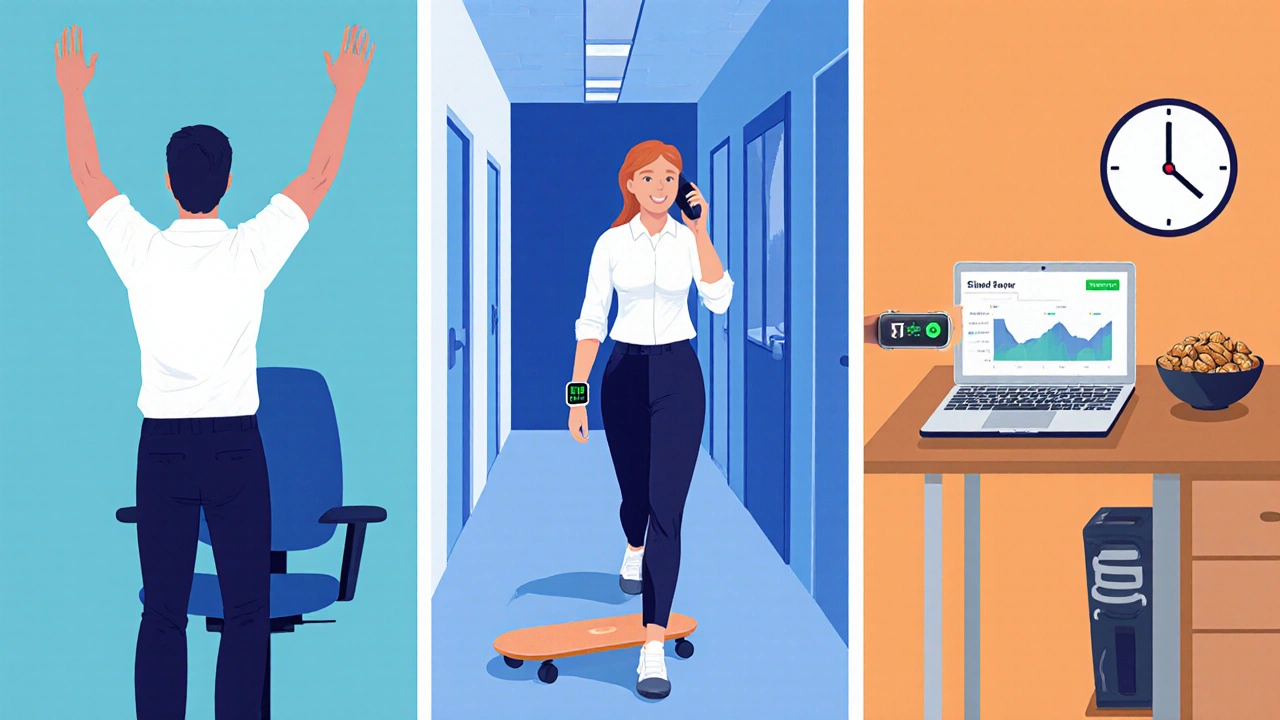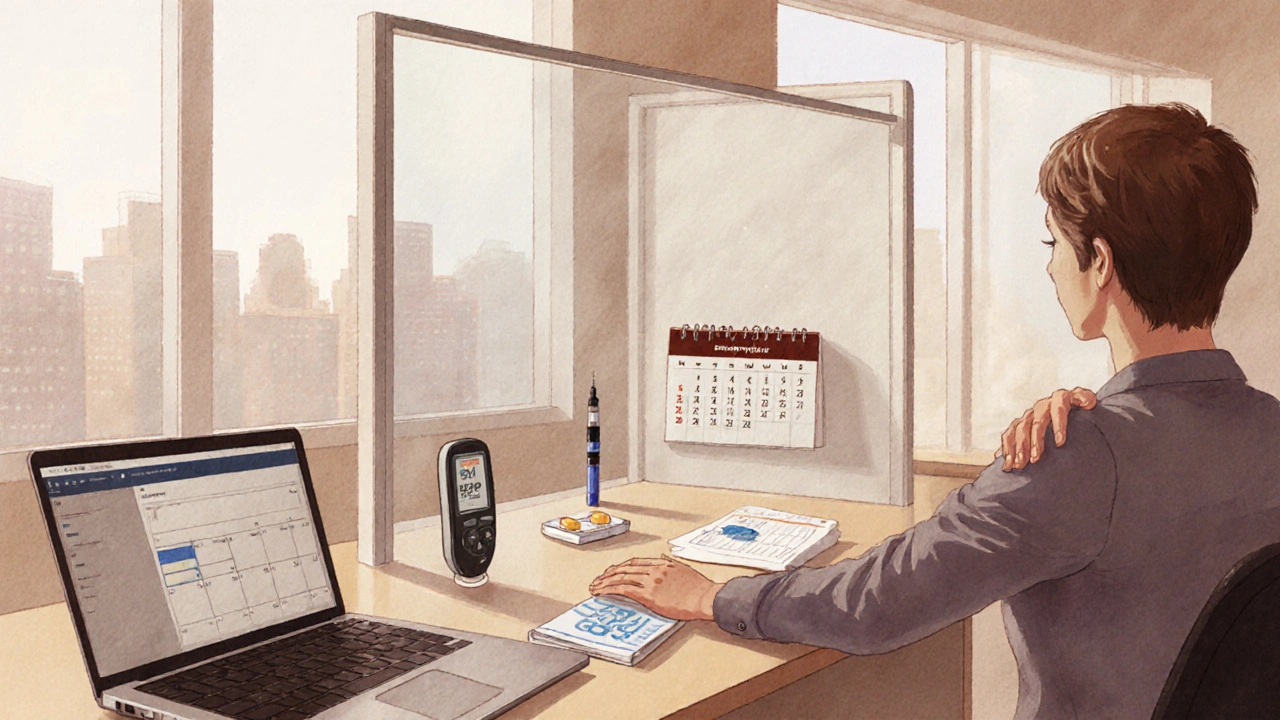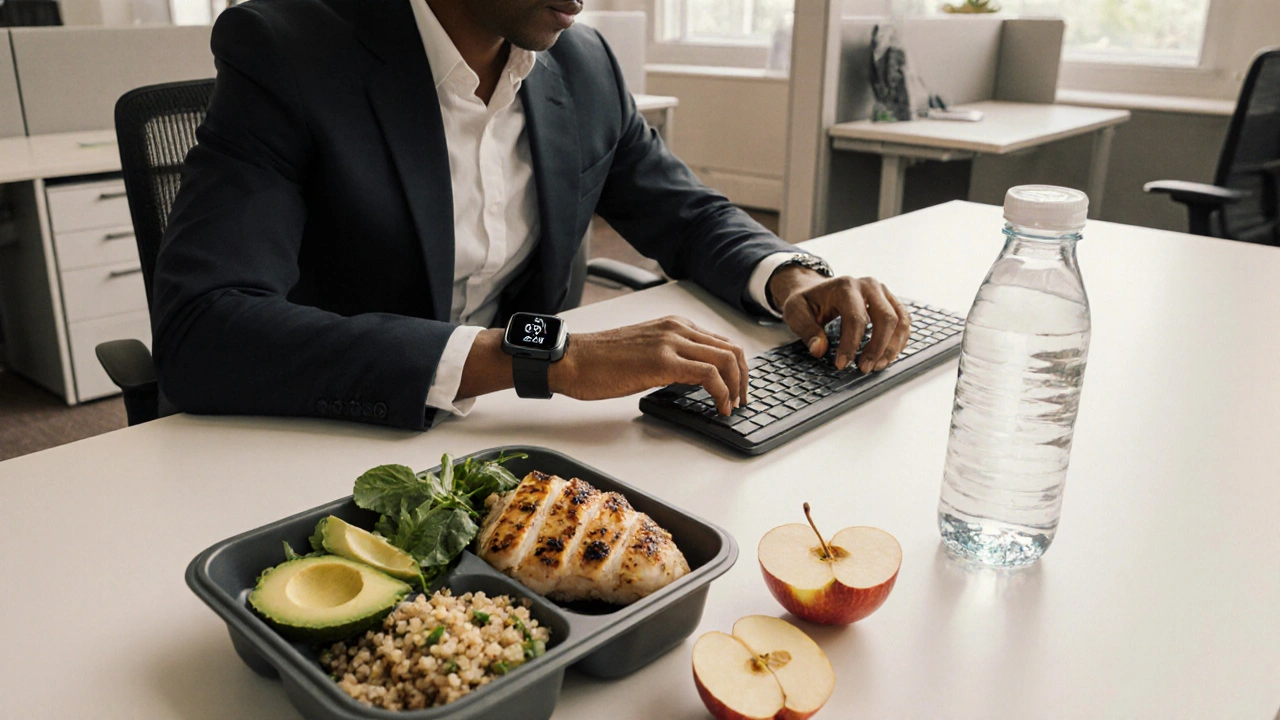Workplace Blood Sugar Calculator
Blood Sugar Impact Calculator
Estimate how your meal choices, activity, and stress affect blood sugar levels at work.
Your blood sugar may rise by - mg/dL
Quick Takeaways
- Know your condition: blood‑sugar patterns, medication timing, and warning signs.
- Plan meals and snacks that keep glucose stable during shifts.
- Use discreet glucose‑monitoring tools or continuous glucose monitors (CGM) at your desk.
- Request reasonable accommodations-flexible breaks, private space for testing, or ergonomic adjustments.
- Communicate early with your manager and occupational health team to prevent emergencies.
If you have type 2 diabetes, managing it at work can feel challenging. The good news is that with a few smart habits and the right support, you can keep your energy steady, avoid unexpected lows or highs, and stay productive.
Understanding Type 2 Diabetes in the Workplace
Living with type 2 diabetes is a chronic condition where the body either resists insulin or doesn’t produce enough, leading to elevated blood glucose levels. In a typical workday, stress, irregular meals, and long periods of sitting can push glucose up or down, affecting focus and mood. Knowing how your body reacts to the office environment helps you set realistic expectations and avoid surprises.
Key factors that influence blood sugar at work include:
- Meal timing and composition.
- Physical activity-or lack thereof-during the day.
- Stress hormones (cortisol) that raise glucose.
- Medication schedules that may need adjustment around meetings or travel.
Monitoring Blood Sugar Without Disrupting Your Flow
Modern technology makes it easier to keep tabs on glucose without drawing attention. glucose monitoring devices, especially continuous glucose monitors (CGM), send real‑time readings to a smartphone or smartwatch. A quick glance tells you whether you’re drifting high or low, so you can act before symptoms appear.
Tips for seamless monitoring:
- Choose a CGM or finger‑stick device with a discreet transmitter.
- Set alerts for threshold values that matter to you (e.g., 70mg/dL and 180mg/dL).
- Keep a small log in a secure note app to spot patterns over weeks.
- If you prefer traditional meters, store them in a desk drawer and use a quick‑release lancet for fast tests.
Remember, under most workplace privacy laws, your health data is confidential. Only share readings when you need support or to demonstrate the need for a break.

Meal Planning and Smart Snacking at the Desk
Food is the fastest way to swing blood sugar up or down. Aim for meals that combine low‑glycemic carbs, protein, and healthy fats. A typical office lunch might look like:
- Grilled chicken or tofu (protein).
- Quinoa or a whole‑grain wrap (complex carbs).
- Avocado, olive oil, or nuts (fat).
- Leafy greens or roasted veggies (fiber).
For snacks, keep portable options handy:
- Greek yogurt with berries.
- Apple slices with almond butter.
- Hard‑boiled eggs and a handful of olives.
- Low‑sugar protein bars (check label for net carbs).
Timing matters too. If you know you have a two‑hour meeting, grab a snack 15 minutes beforehand to prevent a dip. Log the snack in your monitoring app so you can see its impact.
Staying Active When Your Job Is Mostly Sitting
Physical activity boosts insulin sensitivity, meaning your cells use glucose more efficiently. Even office workers can embed movement without leaving their desk.
Ideas to keep moving:
- Set a timer to stand or stretch every 45 minutes.
- Take a quick walk around the floor during phone calls.
- Use a standing desk or a balance board for part of the day.
- Do chair‑based exercises (leg lifts, seated twists) during low‑focus tasks.
For those with a flexible schedule, schedule a 20‑minute walk during lunch. Research from the Australian Diabetes Society (2024) showed that a daily 30‑minute walk reduced average post‑lunch glucose by 12mg/dL.
Managing Stress: The Hidden Blood‑Sugar Trigger
Stress ramps up cortisol, which tells the liver to release more glucose. In a high‑pressure office, this can lead to chronic “stress‑hyperglycemia.”
Effective stress‑busting tools:
- Mindfulness breathing - a 2‑minute box‑breath (4‑4‑4‑4) lowers cortisol within minutes.
- Short “micro‑breaks” for stretching or a quick walk outside.
- Use a noise‑cancelling headset to create a focused zone.
- Talk to a trusted colleague or employee assistance program when workload feels overwhelming.
Tracking stress levels alongside glucose can reveal patterns. Many CGM apps now include a mood tag-use it to note high‑stress periods.
Know Your Rights: Workplace Accommodations You Can Request
In Australia, the Fair Work Act and the Disability Discrimination Act obligate employers to provide reasonable adjustments for chronic conditions like diabetes. Common accommodations include:
| Accommodation | What It Looks Like | How It Helps |
|---|---|---|
| Flexible break times | 10‑minute glucose‑check break every 3‑4 hours | Prevents hypo‑ or hyper‑glycemic episodes |
| Private testing area | Designated restroom or quiet room | Allows discreet monitoring and insulin administration |
| Ergonomic workstation | Adjustable chair, footrest, or sit‑stand desk | Improves circulation and reduces post‑prandial spikes |
| Meal‑prep support | Company fridge, microwave, or stored snack lockers | Ensures access to healthy meals during shift changes |
| Emergency plan | Designated colleague trained to recognize severe hypo | Quick response can prevent loss of consciousness |
When requesting accommodations, be clear about the specific need, the frequency, and how it benefits productivity. A short email to HR outlining the request and attaching a brief doctor note is usually enough.

Communicating with Your Manager and Colleagues
Transparency builds trust, but you control how much detail you share. A simple script can help:
“Hi [Manager], I have type 2 diabetes, which means I need to check my blood sugar a few times a day. I’d like to discuss a brief break schedule that won’t affect our deadlines.”
Key points to cover:
- Why monitoring is essential for safety.
- How the accommodation fits into your workflow.
- Reassurance that performance will remain high.
For teammates, a quick note like “I’ll be stepping away for a quick check in 5minutes” normalizes the act and reduces stigma.
Preparing for Emergencies
Even with perfect planning, lows can happen. Have a personal emergency kit:
- Fast‑acting glucose tablets (3‑4 tablets for a mild hypoglycemia).
- Glucose gel or juice pack for situations where tablets aren’t practical.
- A small card with your emergency contacts and a brief description of your condition.
- If you use an insulin pump, a backup battery and a spare infusion set.
Make sure at least one trusted coworker knows how to administer a glucagon injection if you’re unable to respond. A quick demo during a health‑and‑safety briefing can save lives.
Daily Checklist for Managing Type 2 Diabetes at Work
- Review your glucose trend from the night before.
- Pack a balanced breakfast and a mid‑morning snack.
- Set CGM alerts for 70mg/dL and 180mg/dL.
- Schedule a 5‑minute stand‑up break every 90 minutes.
- Log meals and any stress events in your monitoring app.
- Confirm your emergency kit is in your desk drawer.
- Check in with your manager about any needed adjustments for the day.
Cross‑checking this list each morning takes less than two minutes but pays off in stable energy and confidence.
Frequently Asked Questions
Can I test my blood sugar at my desk without breaking confidentiality?
Yes. Most CGM devices sync to a smartwatch or phone, letting you glance at the reading discretely. If you use a finger‑stick meter, keep the device in a drawer and take a quick test during a scheduled break.
Do I need to disclose my diabetes to coworkers?
Disclosure is optional. You only need to inform those who might need to act in an emergency (e.g., a close teammate). Your manager and HR should know enough to arrange reasonable accommodations.
What if my employer refuses a reasonable accommodation?
Under the Fair Work Act, employers must consider adjustments for chronic health conditions. If a request is denied, you can raise the issue with your union, seek advice from the Australian Human Rights Commission, or consult a workplace lawyer.
How can I keep my meals healthy when office catering is unhealthy?
Bring your own meals in a fridge‑friendly container. If that’s impossible, opt for the protein‑first option on the buffet, add a side salad, and skip sugary sauces. Small swaps add up.
Is it safe to work night shifts with type 2 diabetes?
Night shifts can disrupt circadian rhythms, affecting insulin sensitivity. If you must work nights, coordinate with your doctor to adjust medication timing, monitor glucose more frequently, and prioritize sleep hygiene.
Can stress at work cause long‑term damage to my diabetes control?
Chronic stress elevates cortisol, which can raise fasting glucose and contribute to insulin resistance over time. Incorporating regular stress‑reduction techniques can improve both mental health and glycemic control.
Managing type 2 diabetes at work isn’t a one‑size‑fits‑all plan. The key is to blend medical guidance with practical workplace strategies. By monitoring, planning meals, staying active, and using your legal rights, you can keep your health steady and your career moving forward.



Stephanie Cheney
First off, great overview! I love how you broke down the practical steps for monitoring glucose discreetly. Setting up CGM alerts and keeping a small snack drawer are game‑chasers. Also, it’s key to talk to your manager early so accommodations feel natural. Keep pushing forward, you’ve got this!